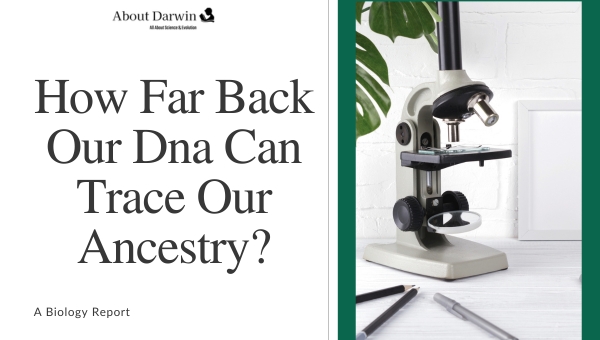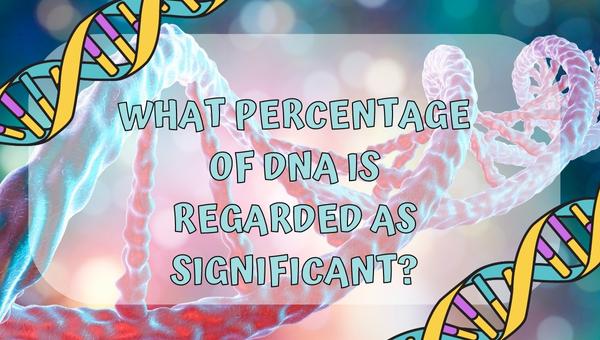Physical Address
304 North Cardinal St.
Dorchester Center, MA 02124
Did you know that approximately 99.9% of your DNA is identical to every other human? Yet, the remaining 0.1% can reveal much about your genetic history. DNA can trace our ancestry far back.
As you delve into the world of genealogy, you might wonder just how far back DNA tests can trace your ancestry. Imagine discovering if you share a common ancestor with Cleopatra or Genghis Khan!
Whether it’s mtDNA testing, YDNA testing, or AncestryDNA, each one offers its unique perspective on your lineage. This article will explore how deep they can delve into your past and what significance different percentages have in tracing back generations.
So tighten up your lab coats and get ready for an intriguing journey through time, all within the tiny strands of your DNA.

Contents
Believe it or not, the mitochondrial DNA test holds the record for tracing back our ancestors the furthest! This fascinating genetic tool allows scientists to dive deep into our past and make connections with ancient humans.
The oldest DNA discovered through this method has revealed genetic ties to early human populations dating back hundreds of thousands of years. It’s a bit like time travel but with your genes!
Mitochondrial DNA tests are instrumental in Neanderthal ancestry tracing and ancestral population comparisons. They can highlight genetic mutations tracking all the way back to these enigmatic ancient relatives of ours. It’s incredible how we carry remnants of their DNA within us today.
Ancient DNA studies have opened new doors in understanding our human journey. They’ve brought us closer to those who walked this Earth long before us, showing that we’re all part of one big interconnected family tree. And isn’t there something comforting about knowing you belong to such an extensive lineage?
So next time you look at your family photo album, remember: your history goes much deeper than what meets the eye! Your very cells bear testament to this epic saga unfolding over millennia.
Imagine the thrill of discovering that mtDNA testing can unveil your lineage up to a staggering 200,000 years ago! Indeed, mitochondrial DNA (mtDNA) testing offers an incredible journey into your ancient ancestry.
Here are the key aspects:
As you delve deeper into this analysis, you’ll find belonging in a larger story that encompasses not just your family or community but all humanity. You’re part of a grand tapestry woven through the ages, connecting you directly with prehistoric humans who once roamed the earth.
So, remember next time when someone asks about your roots: Your story doesn’t start with your grandparents or even great-grandparents – it stretches far beyond them, reaching back nearly 200 millennia!
Diving into your ancestry can get even more detailed with YDNA testing. This type of testing utilizes SNP (Single Nucleotide Polymorphism) tests and STR (Short Tandem Repeat) tests to trace back your paternal lineage.
With these tools, it’s possible to delve deep into the past, revealing a rich tapestry of information about your ancestors that you may not have known was there.
SNP tests can trace your ancestry from around 1,000 to 2,000 years ago, shedding light on about 10-20 generations of your family’s past. These tests examine Single Nucleotide Polymorphisms (SNPs), DNA variations, and genetic markers in our genome.
SNPs help establish your genetic genealogy by pinpointing specific changes in the DNA sequence. Over time, these genetic markers can link you to a particular ancestral population. They also shed light on how genes have evolved and migrated over centuries.
Your unique set of SNPs is part of your genetic inheritance from previous generations. This data allows you to connect with others who share similar SNP patterns.
Unraveling this intricate thread of history can foster a deep sense of belonging.
It’s truly astonishing how STR tests can unravel the intricate tapestry of your lineage, sparking a profound connection to your roots. These tests analyze specific regions of DNA where short tandem repeats (STRs) occur, offering deep insights into genetic variations and mutations.
| Genetic Marker | DNA Sequencing | Genomic Data |
|---|---|---|
| STR | High Accuracy | Rich & Diverse |
| SNP | Lower Accuracy | Less Varied |
| Indel | Moderate Accuracy | Moderately varied |
The table above compares different types of genetic markers used in ancestry tracing. The high accuracy and rich genomic data make STR analysis an excellent tool for exploring your heritage. Embrace this fascinating journey through time and discover the unique sequences that tell your story through generations.
AncestryDNA can trace your roots roughly 500 to 1000 years, peering into the past like a time-traveling detective. This timeframe strikes an optimal balance between Ethnicity Accuracy and DNA Degradation.
As time passes, genetic instructions change, and some information is lost due to natural degradation processes. However, AncestryDNA can precisely map out your lineage by focusing on specific Genetic Markers, which are sections of DNA with a known location on a chromosome.
The test also explores your Ancestral Migration patterns, revealing who you are and where you come from geographically. Analyzing thousands of reference samples worldwide provides insights into the movement and intermingling of your forebears over centuries.
Interestingly enough, AncestryDNA can even uncover any Neanderthal Ancestry lurking in your genes. A small percentage of our DNA comes from these early humans whom our ancestors encountered when migrating out of Africa.
In weaving together the threads of your unique story, AncestryDNA unveils ancestral relationships and geographical origins, providing a sense of belonging across time and space. You’re not just part of history; thanks to this technology, you carry its echoes in every cell.
Believe it or not, even a minuscule 1% of your genetic makeup can reveal volumes about your ancestral heritage! DNA accuracy is crucial in genealogy research because it provides a clearer picture of our roots.

The more accurate the DNA, the more reliable and definite our understanding of our ancestry becomes.
Let’s delve deeper into what aspects make this possible:
Though percentages may seem insignificant when considering vast timelines and countless generations, remember that every bit counts. Each fraction of a percent carries with it stories of ancient migrations, cultures embraced, battles waged, and love shared – all intricately woven into the tapestry that is you.
Are you curious how deep into the past 2% of your genetic material can reach? It’s more considerable than you might think. DNA accuracy and precision play a significant role in answering this question.
Genetic markers, specific regions of DNA that vary from person to person, help us trace our lineage back to our ancestors.
In each generation, roughly half of each parent’s DNA is passed down, meaning the amount of DNA you share with an ancestor decreases by around 50% with every generation. For instance, you share approximately 50% of your DNA with each parent and about 25% with each grandparent.
By the time we get to great-great-great-grandparents (five generations back), it’s likely that you carry just over 3% of their DNA.
When considering an even smaller percentage like 2%, it equates approximately to six or seven generations back. However, this is not set in stone due to the randomness involved in passing on genetic markers.
Ancestral migration and ethnicity estimation can also influence these percentages as different populations have unique variations within their shared DNA.
So while we cannot pinpoint exact timelines through our genetic makeup, our genes do offer intriguing insights into our pasts and connect us all as one big global family.
When we’re talking about a mere 1% of genetic material, it’s equivalent to roughly eight or nine generations ago. For instance, imagine discovering that you share just 1% of your genes with a person living in the late 18th century, this could mean that you are likely connected to them through a common ancestor from that time period!
This traceability limit is essentially our DNA percentage at work, creating ancestral connections that might seem astonishingly distant yet are irrefutably part of our genetic heritage.
Understanding these traces can be an intricate process. The generation count is not always precise since the DNA percentage one inherits isn’t equally distributed across all ancestors.
In other words, while you might carry 1% DNA from an ancestor eight generations back, it doesn’t necessarily imply you carry the same proportion from all your forebears in that era.
This fascinating science gives us a sense of belonging and connection to history. It reminds us we’re part of a bigger picture painted by countless generations before us.
Through our DNA, we hold keys to past lives and stories, connecting us intimately with diverse cultures and epochs, helping shape our identity and understand ourselves better in the broader narrative of human evolution.
READ MORE: Hiring a Professional Genealogist: Detailed Guide With Cost
Through DNA sampling, your ancestry is traced using genetic genealogy. Genetic markers reveal ethnic variations, offering a detailed map of your lineage. This genealogical research provides an intimate connection to your unique heritage.
YDNA tests your paternal lineage through genetic markers. mtDNA traces your maternal ancestry via DNA mutations. AncestryDNA examines your genetic inheritance, providing a broader view of your lineage and belonging.
Navigating your ancestry through DNA is like sailing uncharted waters. Testing inaccuracies, DNA mutations, sample contamination, interpretation challenges and privacy concerns are potential storms on the journey to understanding where you truly come from.
Yes, DNA testing can reveal ancestral traits and health. Genetic markers can indicate genetic diseases your ancestors may have had. However, DNA interpretation isn’t definitive; it gives an overview of ancestral health patterns.
Yes, you can trace your ancestry to specific countries or regions using DNA testing. By analyzing genetic markers, the significance of ethnicity determination and migration patterns becomes evident, pinpointing ancestral homelands while maintaining DNA data privacy.
So, you’ve learned that DNA testing can trace your ancestry remarkably far back. Most intriguingly, mtDNA testing can trace up to 200,000 years of your maternal lineage!
This fascinating science allows us to connect with our past in a unique way. Remember though, only consider a connection significant if it makes up at least 1% of your DNA – roughly equivalent to 7 generations back.
Dive into your roots and discover the rich tapestry of your ancestry!